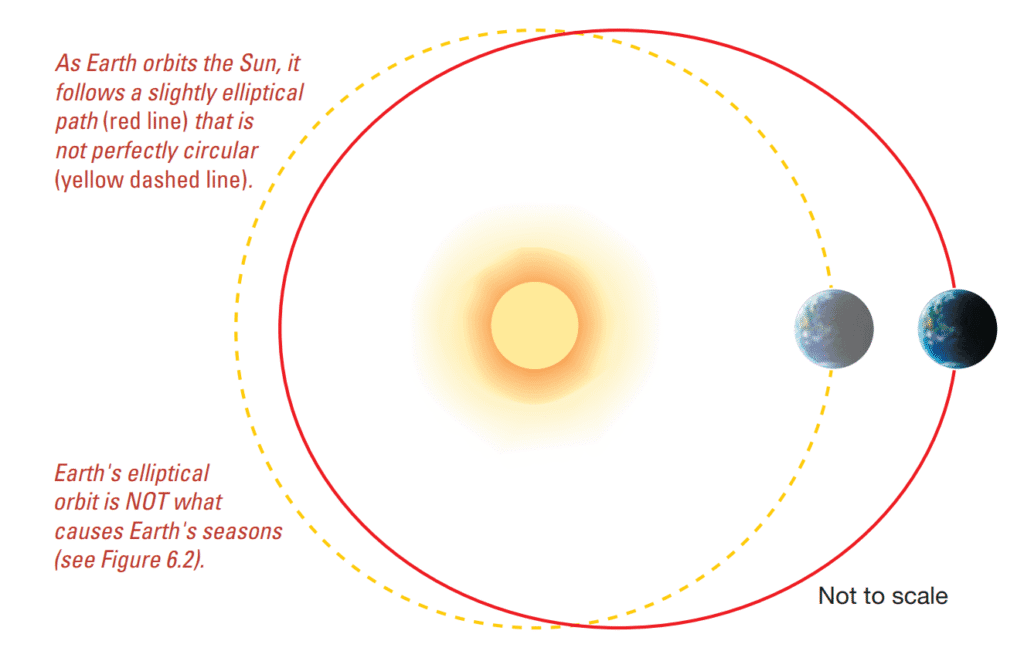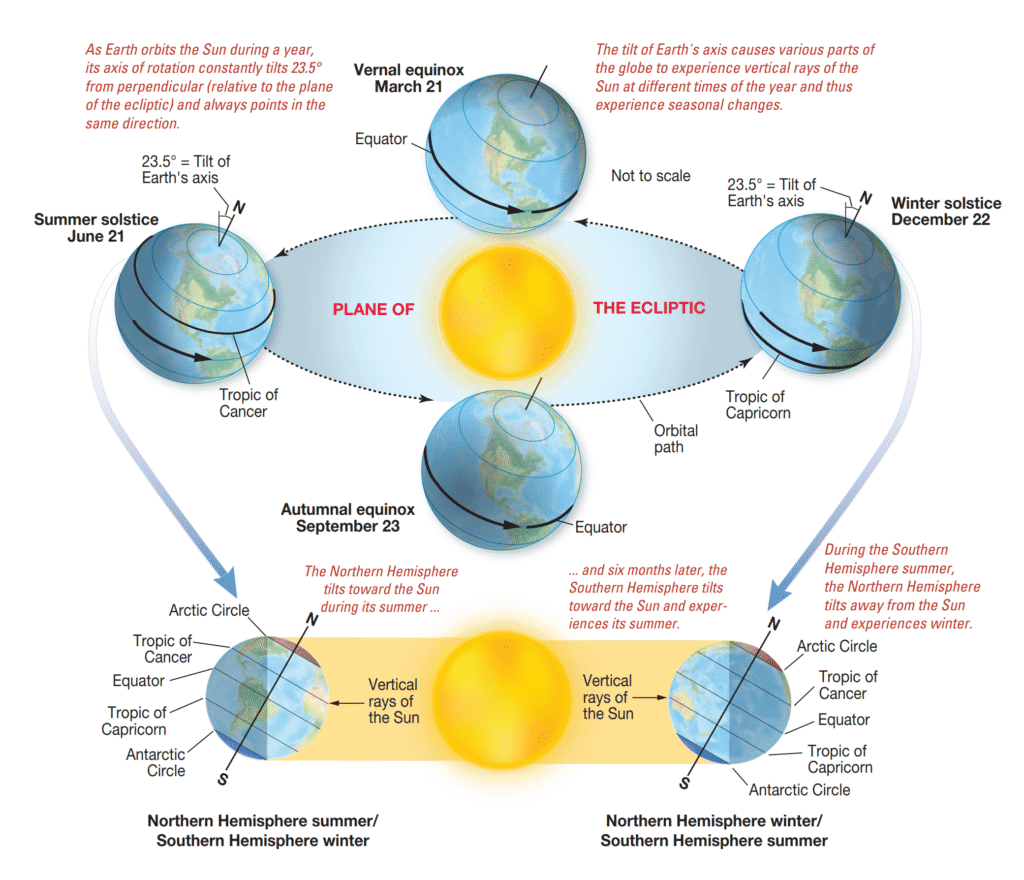What Causes Earth’s Seasons?
This seemingly straightforward inquiry often leads to a common misunderstanding: Although Earth follows an elliptical trajectory around the Sun that deviates only minimally from a perfect circle, the changing distance between Earth and the Sun is not the primary cause of seasonal variation. Instead, as elaborated below, the fundamental factor influencing the seasons is the inclination of Earth’s rotational axis.

The Plane of the Ecliptic and Axial Tilt
The imaginary surface formed by connecting all orbital positions of Earth is referred to as the plane of the ecliptic. More significantly, Earth’s axis of rotation does not stand perpendicular to this plane; rather, it is tilted at an angle of 23.5 degrees. Consequently, during Earth’s annual revolution around the Sun, one hemisphere becomes more directly oriented toward the Sun while the other is tilted away. This axial inclination is the essential reason for the occurrence of seasons, rather than Earth’s slightly elliptical path. A notable outcome of this axial tilt is the consistent orientation of Earth’s axis in space, which continuously points toward Polaris, the North Star, throughout the annual cycle.
Thus, it is the inclination of Earth’s rotational axis, not the shape of its orbit, that gives rise to seasonal variations. To understand this phenomenon clearly, one can observe the annual cycle of seasons—spring, summer, autumn, and winter—as follows:
The Annual Cycle of Seasons

Vernal Equinox
During the vernal equinox (vernus = spring; equi = equal, noct = night), which generally falls around March 21, the Sun is positioned directly overhead at the equator. At this juncture, every location across the globe experiences an equal duration of day and night, giving the equinox its name. In the Northern Hemisphere, this date also marks the spring equinox.
Summer Solstice
The summer solstice (sol = Sun, stitium = a halting point), which typically occurs near June 21, marks the Sun’s northernmost position in the sky, directly above the Tropic of Cancer at 23.5 degrees north latitude. For observers on Earth, the Sun appears to reach its highest declination at noon before momentarily “pausing” in its apparent movement—hence the term solstice—prior to beginning the next half of its annual journey.
Autumnal Equinox
The autumnal equinox (autumnus = fall), occurring approximately on September 23, is when the Sun again aligns directly over the equator. In the Northern Hemisphere, this moment is referred to as the fall equinox, and once again, day and night durations are nearly identical across the globe.
Winter Solstice
The winter solstice, which takes place around December 22, finds the Sun positioned directly overhead at the Tropic of Capricorn, located at 23.5 degrees south latitude. During this period, the Southern Hemisphere is tilted most directly toward the Sun. Consequently, this solstice signifies the commencement of summer for the Southern Hemisphere due to its maximal solar exposure.
Solar Declination and Its Effects
Due to the 23.5-degree inclination of Earth’s rotational axis, the Sun’s declination—defined as its angular displacement relative to the equatorial plane—fluctuates annually between 23.5 degrees north and 23.5 degrees south of the equator. This variation results in the zone bounded by these latitudes, known as the tropics, receiving a significantly higher concentration of solar radiation throughout the year compared to the polar regions.
These seasonal fluctuations in both the Sun’s elevation angle and the duration of daylight exert a profound impact on global climatic patterns. For instance, within the Northern Hemisphere, the longest day of the year occurs during the summer solstice, while the shortest day is experienced on the winter solstice.
Climate Patterns and Polar Extremes
The daily pattern of solar heating plays a crucial role in shaping climate across most regions of the globe. However, this general rule does not apply in areas located north of the Arctic Circle (66.5 degrees north latitude) and south of the Antarctic Circle (66.5 degrees south latitude), which undergo extreme variations in sunlight exposure throughout the year.
For example, during winter in the Northern Hemisphere, territories situated above the Arctic Circle receive no direct solar radiation, resulting in extended periods of darkness lasting as long as six continuous months. Simultaneously, the regions below the Antarctic Circle are subjected to uninterrupted solar illumination, commonly referred to as the “midnight Sun,” thereby experiencing up to six months of daylight.
Approximately six months later, as the Northern Hemisphere enters summer and the Southern Hemisphere transitions into winter, this solar exposure pattern undergoes a complete reversal.
What is the primary cause of Earth’s seasons?
The fundamental cause of the seasons is the 23.5-degree tilt (inclination) of Earth’s rotational axis. This tilt causes one hemisphere to be more directly oriented toward the Sun while the other is tilted away during Earth’s annual orbit.
Does the distance between the Earth and Sun cause the seasons?
No. Although Earth has a slightly elliptical orbit, the changing distance from the Sun is not the primary reason for seasonal variations. The axial tilt is the essential factor.
What is the difference between a solstice and an equinox?
A solstice marks the point when the Sun is at its northernmost or southernmost position in the sky (e.g., summer and winter solstices). An equinox occurs when the Sun is directly over the equator, resulting in nearly equal day and night durations across the globe (e.g., spring and autumn equinoxes).
What happens at the Arctic and Antarctic Circles during winter?
Due to Earth’s tilt, regions above the Arctic Circle receive no direct sunlight during the Northern Hemisphere’s winter, leading to up to six months of darkness. Simultaneously, the Antarctic Circle experiences up to six months of continuous daylight, known as the “midnight Sun.” This pattern reverses six months later.
What is the “plane of the ecliptic”?
The plane of the ecliptic is the imaginary flat surface formed by connecting all the points in Earth’s orbit as it revolves around the Sun. Earth’s axis is tilted 23.5 degrees relative to this plane.
Reference: All images and content are taken from Essentials of Oceanography by Alan P. Trujillo and Harold V. Thurman, 12th Edition.
